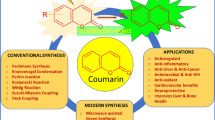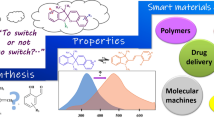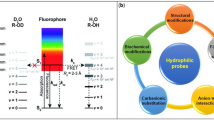Abstract
Rhodamine derivatives are heterocyclic compound, related to the fluorescent probe having a profound application in the field of biotechnology. Herein, we present two new synthesized rhodamine based fluorescent probes from the rhodamine B (probe 1) and rhodamine 6G (probe 2), respectively. The structures of the synthesized probes 1 and 2 were confirmed using 1H NMR and LC-MS spectral techniques. Further, photophysical properties such as absorption, emission and fluorescence lifetime were examined and compared for both the probes under identical conditions. These comparable data provide a possibility to discuss the mechanism which controls the fluorescence properties of probes. The data also showed that the probes in different solvent environment induce a gradual change in the molecular structure and produce a change in fluorescent intensity as a sensory signal. The changes in fluorescence lifetime and quantum yield with the parent compounds are because of change in solvent polarity and also due to the rigidity of the alkyl groups on N atoms in molecular structure. Moreover, the cell imaging and cellular toxicity studies using the probes were performed. Notably, the result obtained in this study suggests that the probe 2 has significant application in the field of cellular imaging or biotechnology.






Similar content being viewed by others
REFERENCES
Wang, Z., Yang, M., Chen, C., Zhang, L., and Zeng, H., Sci. Rep., 2016, vol. 6, 29611, pp. 1–7.
Adak, A.K., Dutta, B., Manna, S.K., and Sinha, C., ACS Omega., 2019, vol. 21, pp. 18987–18995.
Abebe, F., Perkins, P., Shaw, R., and Tadesse, S., J. Mol. Struct., 2020, vol. 1205, p. 127594.
Savarese, M., Aliberti, A., De Santo, I., Battista, E., Causa, F., Netti, P.A., and Rega, N., J. Phys. Chem. A., 2012, vol. 116, pp. 7491–7497.
Ganbold, E.O., Park, J.H., Dembereldorj, U., Ock, K.S., and Joo, S.W., J. Raman Spectrosc., 2011, vol. 42, pp. 1614–1619.
Bujdak, J., J. Photochem. Photobiol. C, 2018, vol. 35, pp. 108–133.
Lewkowicz, A., Bojarski, P., Synak, A., Grobelna, B., Akopova, I., Gryczyński, I., and Kułak, L., J. Phys. Chem. C., 2012, vol. 116, pp. 12304–12311.
Stewart, B.W. and Wild, C.P., World Cancer Report 2014, IARC, 2014, p. 630.
Singh, K., Rotaru, A.M., and Beharry, A.A., ACS Chem. Biol., 2018, vol. 13, pp. 1785–1798.
Luo, S., Zhang, E., Su, Y., Cheng, T., and Shi, C., Biomaterials., 2011, vol. 32, pp. 7127–7138.
Jang, Y.K., Nam, U.C., Kwon, H.L., Hwang, I.H., and Kim, C., Dye Pigment., 2013, vol. 99, pp. 6–13.
Mahajan, D., Khairnar, N., Bondhopadhaya, B., Sahoo, S.K., Basu, A., Singh, J., Singh, N., Bendre, R., and Kuwar, A., New J. Chem., 2015, vol. 39, pp. 3071–3076.
Sorokin, P.P. and Lankard, J.R., J. Res. Dev., 1966, vol. 10, pp. 162–163.
Zhang, X.F., Zhang, Y., and Liu, L., J. Lumin., 2014, vol. 145, pp. 448–453.
Kojima, H, Hirotani, M, Nakatsubo, N, Kikuchi, K, Urano, Y, Higuchi, T, Hirata, Y, Nagano, T., Anal. Chem., 2001, vol. 73, pp. 1967–1973.
Saleem, M. and Lee, K.-H., J. Lumin., 2014, vol. 145, pp. 843–848.
Ettinger, A. and Wittmann, T., Methods Cell Biol., 2014, vol. 123, pp.77–94.
Phull, A.R., Majid, M., ul Haq, I., Khan, M.R., and Kim, S.J., Int. J. Biol. Macromol., 2017, vol. 97, pp. 468–480.
Li, H., Fan, J., Wang, J., Tian, M., Du, J., Sun, S., Sun, P., and Peng, X., Chem. Commun., 2009, pp. 5904–5906.
Penzkofer, A. and Leupacher, W., J. Lumin., 1987, vol. 37, pp. 61–72.
Kubin, R.F. and Fletcher, A.N., J. Lumin., 1982, vol. 27, pp. 455–462.
Fischer, M. and Georges, J., Chem. Phys. Lett., 1996, vol. 260, pp. 115–118.
Drexhage, K.H.H, J. Res. Natl. Bur. Stand. Sect. A. Phys. Chem. 1976, vol. 80, p. 421.
Vogel, M., Rettig, W., Sens, R., and Drexhage, K.H., Chem. Phys. Lett., 1988, vol. 147, pp. 452–460.
ACKNOWLEDGMENTS
The authors would like to thank Dr. Rajendran Nagarajan and Mr. Balasaheb D. Vanjare for providing comments regarding the revised manuscript.
Funding
This research was supported by Basic Science Research Program through the National Research Foundation of Korea (NRF) funded by the Ministry of Education (NRF-2019R1I1A3A01059089).
Author information
Authors and Affiliations
Corresponding author
Ethics declarations
COMPLIANCE WITH ETHICAL STANDARDS
This article does not contain any studies involving animals or human participants performed by any of the authors.
Conflict of Interests
The authors declare that they no conflict of interests.
Rights and permissions
About this article
Cite this article
Harini Sampath Kumar, Choi, CS. & Lee, K.H. Synthesis, Photophysical Properties, and Cytotoxicity of Rhodamine Based Fluorescent Probes. Russ J Bioorg Chem 47, 691–699 (2021). https://doi.org/10.1134/S1068162021030109
Received:
Revised:
Accepted:
Published:
Issue Date:
DOI: https://doi.org/10.1134/S1068162021030109




